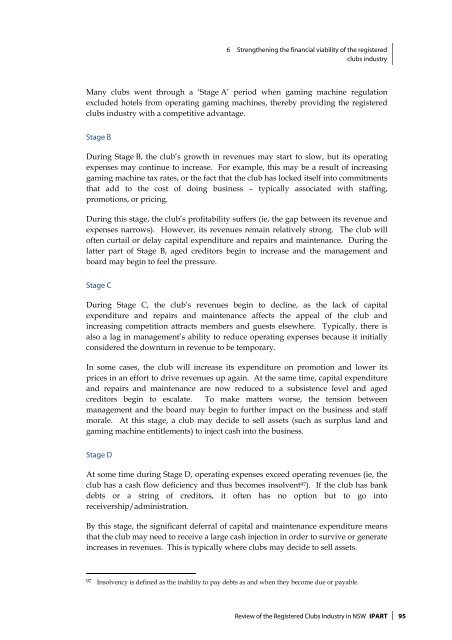Review of the Registered Clubs Industry in NSW - Clubs NSW
Review of the Registered Clubs Industry in NSW - Clubs NSW
Review of the Registered Clubs Industry in NSW - Clubs NSW
Create successful ePaper yourself
Turn your PDF publications into a flip-book with our unique Google optimized e-Paper software.
6 Streng<strong>the</strong>n<strong>in</strong>g <strong>the</strong> f<strong>in</strong>ancial viability <strong>of</strong> <strong>the</strong> registered<br />
clubs <strong>in</strong>dustry<br />
Many clubs went through a ‘Stage A’ period when gam<strong>in</strong>g mach<strong>in</strong>e regulation<br />
excluded hotels from operat<strong>in</strong>g gam<strong>in</strong>g mach<strong>in</strong>es, <strong>the</strong>reby provid<strong>in</strong>g <strong>the</strong> registered<br />
clubs <strong>in</strong>dustry with a competitive advantage.<br />
Stage B<br />
Dur<strong>in</strong>g Stage B, <strong>the</strong> club’s growth <strong>in</strong> revenues may start to slow, but its operat<strong>in</strong>g<br />
expenses may cont<strong>in</strong>ue to <strong>in</strong>crease. For example, this may be a result <strong>of</strong> <strong>in</strong>creas<strong>in</strong>g<br />
gam<strong>in</strong>g mach<strong>in</strong>e tax rates, or <strong>the</strong> fact that <strong>the</strong> club has locked itself <strong>in</strong>to commitments<br />
that add to <strong>the</strong> cost <strong>of</strong> do<strong>in</strong>g bus<strong>in</strong>ess – typically associated with staff<strong>in</strong>g,<br />
promotions, or pric<strong>in</strong>g.<br />
Dur<strong>in</strong>g this stage, <strong>the</strong> club’s pr<strong>of</strong>itability suffers (ie, <strong>the</strong> gap between its revenue and<br />
expenses narrows). However, its revenues rema<strong>in</strong> relatively strong. The club will<br />
<strong>of</strong>ten curtail or delay capital expenditure and repairs and ma<strong>in</strong>tenance. Dur<strong>in</strong>g <strong>the</strong><br />
latter part <strong>of</strong> Stage B, aged creditors beg<strong>in</strong> to <strong>in</strong>crease and <strong>the</strong> management and<br />
board may beg<strong>in</strong> to feel <strong>the</strong> pressure.<br />
Stage C<br />
Dur<strong>in</strong>g Stage C, <strong>the</strong> club’s revenues beg<strong>in</strong> to decl<strong>in</strong>e, as <strong>the</strong> lack <strong>of</strong> capital<br />
expenditure and repairs and ma<strong>in</strong>tenance affects <strong>the</strong> appeal <strong>of</strong> <strong>the</strong> club and<br />
<strong>in</strong>creas<strong>in</strong>g competition attracts members and guests elsewhere. Typically, <strong>the</strong>re is<br />
also a lag <strong>in</strong> management’s ability to reduce operat<strong>in</strong>g expenses because it <strong>in</strong>itially<br />
considered <strong>the</strong> downturn <strong>in</strong> revenue to be temporary.<br />
In some cases, <strong>the</strong> club will <strong>in</strong>crease its expenditure on promotion and lower its<br />
prices <strong>in</strong> an effort to drive revenues up aga<strong>in</strong>. At <strong>the</strong> same time, capital expenditure<br />
and repairs and ma<strong>in</strong>tenance are now reduced to a subsistence level and aged<br />
creditors beg<strong>in</strong> to escalate. To make matters worse, <strong>the</strong> tension between<br />
management and <strong>the</strong> board may beg<strong>in</strong> to fur<strong>the</strong>r impact on <strong>the</strong> bus<strong>in</strong>ess and staff<br />
morale. At this stage, a club may decide to sell assets (such as surplus land and<br />
gam<strong>in</strong>g mach<strong>in</strong>e entitlements) to <strong>in</strong>ject cash <strong>in</strong>to <strong>the</strong> bus<strong>in</strong>ess.<br />
Stage D<br />
At some time dur<strong>in</strong>g Stage D, operat<strong>in</strong>g expenses exceed operat<strong>in</strong>g revenues (ie, <strong>the</strong><br />
club has a cash flow deficiency and thus becomes <strong>in</strong>solvent 97 ). If <strong>the</strong> club has bank<br />
debts or a str<strong>in</strong>g <strong>of</strong> creditors, it <strong>of</strong>ten has no option but to go <strong>in</strong>to<br />
receivership/adm<strong>in</strong>istration.<br />
By this stage, <strong>the</strong> significant deferral <strong>of</strong> capital and ma<strong>in</strong>tenance expenditure means<br />
that <strong>the</strong> club may need to receive a large cash <strong>in</strong>jection <strong>in</strong> order to survive or generate<br />
<strong>in</strong>creases <strong>in</strong> revenues. This is typically where clubs may decide to sell assets.<br />
97 Insolvency is def<strong>in</strong>ed as <strong>the</strong> <strong>in</strong>ability to pay debts as and when <strong>the</strong>y become due or payable.<br />
<strong>Review</strong> <strong>of</strong> <strong>the</strong> <strong>Registered</strong> <strong>Clubs</strong> <strong>Industry</strong> <strong>in</strong> <strong>NSW</strong> IPART 95
















